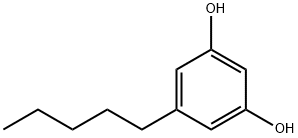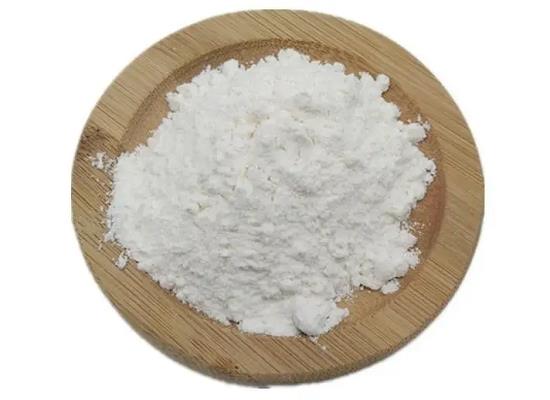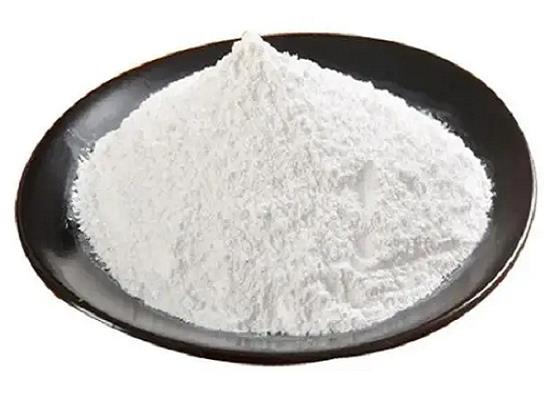The role of olivetol in the human body
Embodiments of the present invention relate to the use of a therapeutically-effective amount of Olivetol to reduce, eliminate, inhibit or alleviate the psychoactive effects of THC in users of Cannabis. Further embodiments of the present invention relate to a softgel, tablet or capsule of Olivetol in combination with an edible oil.
BACKGROUND ART
Cannabis, also commonly known as marijuana, is a flowering plant that includes three species or sub-species, namely sativa, indica and ruderalis. The plant is indigenous to Central Asia and the Indian Subcontinent. Cannabis has long been used for hemp fiber, for oils, for medicinal purposes and as a recreational drug. Cannabis plants produce a group of chemicals called cannabinoids. The majority of these compounds are secreted by glandular trichromes that occur abundantly on the floral calyxes and bracts of female Cannabis plants. When used by humans medicinally or recreationally, Cannabis is typically consumed either eating or smoking dried flower buds, resin, or various extracted oils or waxes.
The most well-known cannabinoid is tetrahydrocannabinol, often abbreviated as"THC." The chemical formula for THC is C2iH30O2 and it has the following chemical structure:
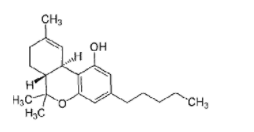
Within the last two years, several states in the United States have legalized or decriminalized the cultivation, possession and use of Cannabis for recreational purposes. As such, some sources estimate that there are many more recreational users of Cannabis than ever before, including new or otherwise inexperienced consumers of Cannabis. Further, with the increased availability of Cannabis, some experienced users may choose to increase their consumption levels. Because some of the perceived negative psychotropic effects of cannabis consumption can be more pronounced or frightening to inexperienced cannabis users, or heavy cannabis users, there is a need for a way or compound that can reduce, alleviate or inhibit the psychotropic effects of cannabis after it has been consumed, or after it has been consumed in a larger than recommended or desired amount.Olivetol (also known as 5-pentylresorcinol or 5-pentyl-l, 3-benzenediol, 5-/7- Amylresorcinol, and 3,5 -Dihydroxyamylbenzene) is a naturally occurring organic compound. The Olivetol chemical formula is CnHi602 and it has the following chemical structure:
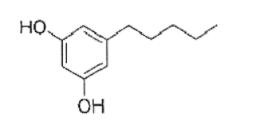
Olivetol is found in certain species of lichens and can be readily extracted. Olivetol is also produced by a number of insects, either as a pheromone, repellent, or antiseptic. The Cannabis plant internally produces the related substance olivetolic acid (OLA). Both Olivetol and OLA can be synthesized in the laboratory. It has been hypothesized that the Cannabis plant in turn utilizes OLA as a component in its biosynthesis of THC. Further information and explanation of Olivetol and OLA are provided in the published paper, "In Vitro And In Vivo Pharmacology Of Synthetic Olivetol-Or Resorcinol-Derived Cannabinoid Receptor Ligands,, M.G. Gascio et al, BRITISH JOURNAL OF PHARMACOLOGY (Oct. 2006) 149(4); 431—440, which is hereby incorporated by reference as though fully set forth herein. Olivetol has been successfully used as a precursor in various laboratory syntheses of THC. However, literature searches reveal no known uses of Olivetol for medicinal or other human consumption purposes.
As such, there is a need for a way or compound that can reduce, alleviate or inhibit the psychotropic effects of cannabis after it has been consumed, or after it has been consumed in a larger than recommended amount.
SUMMARY OF INVENTION
Embodiments of the present invention relate to the use of a therapeutically-effective amount of Olivetol, and/or OLA, in some cases combined with other compounds, in various forms for delivery, to reduce, eliminate, inhibit or alleviate the psychoactive effects of THC in users of Cannabis. DESCRIPTION OF EMBODIMENTS
Olivetol, also known as 5-pentylresorcinol or 5-pentyl-l,3-benzenediol, is a naturally occurring compound with structures analogous to THC. The inventors have demonstrated that consumption of Olivetol, either before or after consumption of THC, will significantly reduce the psychotropic effects of THC ingestion.
It is believed that Olivetol acts as a competitive inhibitor of the cannabinoid receptors CB1 and CB2. Due to its smaller size and its lack of more functional groups, it is believed that Olivetol binds more tightly and/or more aggressively to the cannabinoid receptors CB1 and/or CB2 and has a much lower dissociation constant, allowing it to stay in the active site of the CB receptors for a longer period of time while not activating the receptor, thereby not causing the change in GABA release that is believed to be the mechanism of THC's psychotropic effects.
Olivetol can be consumed following THC ingestion to significantly reduce the psychotropic and other effects of THC, and it is believed that it can be consumed prior to THC ingestion, to dampen these psychotropic and other effects. The range for an effective dose of Olivetol is 8mg to lOOmg, with the preferred range between 30mg and 60mg. However, for certain individuals, larger or smaller doses may be effective, or necessary, suggesting an effective dose range of Olivetol between 4mg to 200mg.
Olivetol is a fat soluble compound that should be combined with and consumed with a human-consumable fatty oil for best absorption in the gastrointestinal tract including in the stomach and small intestine. Any edible oil in which the Olivetol molecule will dissolve will suffice. In one embodiment, Olivetol is mixed with and/or dissolved in olive oil. However other edible oils are suitable, including major food oils such as vegetable, canola, peanut, almond, coconut, avocado, sesame, corn, cottonseed, palm, safflower, rapeseed, soybean, and sunflower; nut oils such as almond, beech nut, brazil nut, cashew, hazelnut, macadamia, mongongo nut, pecan, pine nut, pistachio, and walnut; citrus oils such as grapefruit seed oil, lemon oil, and orange oil; oils from melon and gourd seeds including from the members of the Cucurbitaceae family, such as bitter gourd oil, bottle gourd oil, buffalo gourd oil, butternut squash seed oil, egusi seed oil (from Cucumeropsis mannii naudin seeds), pumpkin seed oil and watermelon seed oil; food supplement oils such as Acai oil (from fruit of several species of the Acai palm), black seed oil (pressed from Nigella sativa seeds), blackcurrant seed oil (from Ribes nigrum seeds), borage seed oil (from Borago officinalis seeds), evening primrose oil (from Oenothera biennis seeds), and flaxseed oil (or linseed oil)(from Linutn sitatissimum seed); or other known edible oils such as amaranth seed oil (from sees of grain amaranth species including Amaranthus cruentus and Amaranthus hypochondriacus), apricot oil, apple seed oil, argan oil (from the seeds of the Argania spinosa), artichoke, avocado, babassu oil (from the seeds of the Attalea speciosd), ben oil (from the seeds of Moringa oleifera), Borneo tallow nut oil (extracted from the fruit of species of genus Shored), cape chestnut oil (also called yangu oil), carob pod oil (Algaroba oil), cocoa butter, cocklebur oil (from species of genus Xanthium), cohune oil (from Attalea cohune), coriander seed, date seed oil, dika oil (from Irvingia gabonensis seeds), false flax oil (from Camelina sativa seeds), grape seed oil, hemp oil, kapok seed oil (from Cieba pentandra seeds), kenaf seed oil (from Hibiscus cannabimis seeds), lallemantia oil (from Lallemantia iberica seeds), mafura oil (from Trichilia emetica seeds), marula oil (from Sclerocarya birrea kernel), meadowfoam seed oil, mustard oil, niger seed oil (including from Guizotia abyssinica), nutmeg butter (extracted by expression fomi the fruit of cogeners of genus Myristicd), nutmeg oil, okra seed oil (from Abelmoschus esculentus seeds), papaya seed oil, papaya oil produced by maceration, perilla seed oil, persimmon seed oil (including from Diospyros virginiand), pequi oil (from Caiyocar basiliense seeds), pili nut oil (from Canarium ovatum seeds), pomegranate seed oil (from Punica granatum seeds), poppy seed oil, pracaxi oil (from Pentaclethra macroloba seeds), prune kernel oil, peach kernel oil, quinoa oil, ramtil oil (from one of several species of genus Guizotia abyssinica seeds), rice bran oil, royle oil (from Prinsepia utilis seeds), sacha inchi oil, sapote oil, seje oil (from Jessenia bataua seeds), shea butter, taramira oil (from arugula or Eruca sativa seeds), tea seed oil (camelia oil), thistle oil (from Silybum marianum seeds), Tigernut oil (or nut-sedge oil, from the Cyperus esculentus tuber), tobacco seed oil (from Nicotiana species seeds, if purified), tomato seed oil, and wheat germ oil. It will be understood that the above list is exemplary, and not meant to be limiting.
The effects of Olivetol on a person who has ingested THC will include but are not limited to clarity of mind, improved vision, increased ability to focus, improved motor skills, and reduction in any other symptoms of THC consumption. [22] A number of real-life, non-clinical trials have been performed by volunteers, to test the effects of the consumption of embodiments of the present invention, the conditions and results of which are described as follows. All tests were performed in "real life," rather than clinical conditions. Various methods of consumption of cannabis were used, such as consumption of edibles, inhalation of cannabis smoke, or inhalation of vapor, depending upon the volunteer's preference. Some subjects reported their pre-consumption mood, pain level, etc., as well as their level of experience with consumption of cannabis. After sufficient exposure to cannabis, each subject indicated when their euphoria or "high" had reached a high level or a peak. Then, the subject took one or more oral doses of an embodiment of the present invention, containing 30 mg of Olivetol combined with edible oil in a "softgel" pill. A timer was started and the subject then reported when they felt an awareness of a decrease or reduction in their euphoria or other cannabis effects, as well as their subjective feelings, mood, pain level or other observations, until they self-reported that their cannabis effects were concluded, hi the majority of cases, subjects noticed a reduction in the effects of cannabis consumption between four to ten minutes, and most commonly six to seven minutes, after talcing a dose of an embodiment of the present invention. Most subjects reported some improved level of mental clarity. However, most subjects also reported that the beneficial effects of their cannabis consumption, such as improved mood or pain reduction, remained even after the euphoric feeling and other physical effects associated with cannabis use declined following their use of a dose or two of an embodiment of the present invention.
Related articles And Qustion
See also
Lastest Price from Olivetol manufacturers

US $0.00/kg2025-04-30
- CAS:
- 500-66-3
- Min. Order:
- 1kg
- Purity:
- 0.99
- Supply Ability:
- 1000kg

US $1.00/g2025-04-21
- CAS:
- 500-66-3
- Min. Order:
- 1g
- Purity:
- 99%
- Supply Ability:
- 1000kg
